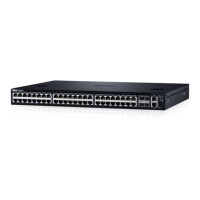Open Shortest Path First (OSPFv2 and OSPFv3)
Open shortest path rst (OSPFv2 for IPv4) and OSPF version 3 (OSPF for IPv6) are supported on Dell Networking OS.
This chapter provides a general description of OSPFv2 (OSPF for IPv4) and OSPFv3 (OSPF for IPv6) as supported in the Dell Networking
Operating System (OS).
NOTE: The fundamental mechanisms of OSPF (ooding, DR election, area support, SPF calculations, and so on) are the same
between OSPFv2 and OSPFv3. This chapter identies and claries the dierences between the two versions of OSPF. Except
where identied, the information in this chapter applies to both protocol versions.
OSPF protocol standards are listed in the Standards Compliance chapter.
Topics:
• Protocol Overview
• OSPF with Dell Networking OS
• Conguration Information
• Conguration Task List for OSPFv3 (OSPF for IPv6)
Protocol Overview
OSPF routing is a link-state routing protocol that calls for the sending of link-state advertisements (LSAs) to all other routers within the
same autonomous system (AS) areas.
Information on attached interfaces, metrics used, and other variables is included in OSPF LSAs. As OSPF routers accumulate link-state
information, they use the shortest path rst (SPF) algorithm to calculate the shortest path to each node.
OSPF routers initially exchange HELLO messages to set up adjacencies with neighbor routers. The HELLO process is used to establish
adjacencies between routers of the AS. It is not required that every router within the AS areas establish adjacencies. If two routers on the
same subnet agree to become neighbors through the HELLO process, they begin to exchange network topology information in the form of
LSAs.
In OSPFv2 neighbors on broadcast and NBMA links are identied by their interface addresses, while neighbors on other types of links are
identied by RID.
Autonomous System (AS) Areas
OSPF operates in a type of hierarchy.
The largest entity within the hierarchy is the autonomous system (AS), which is a collection of networks under a common administration
that share a common routing strategy. OSPF is an intra-AS (interior gateway) routing protocol, although it is capable of receiving routes
from and sending routes to other ASs.
You can divide an AS into a number of areas, which are groups of contiguous networks and attached hosts. Routers with multiple interfaces
can participate in multiple areas. These routers, called area border routers (ABRs), maintain separate databases for each area. Areas are a
logical grouping of OSPF routers identied by an integer or dotted-decimal number.
32
Open Shortest Path First (OSPFv2 and OSPFv3) 539

